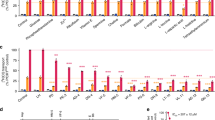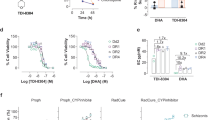Abstract
THE incidence of human malaria has increased during the past 20 years; 270 million people are now estimated to be infected with the parasite1. An important contribution to this increase has been the appearance of malaria organisms resistant to quinoline-containing antimalarials such as chloroquine and quinine2. These drugs accumulate in the acid food vacuoles of the intraerythrocytic-stage malaria parasite3–5, although the mechanism of their specific toxicity in this organelle is uncertain. The primary function of the food vacuole is the proteolysis of ingested red cell haemoglobin6,7 to provide the growing parasite with essential amino acids. Haemoglobin breakdown in the food vacuole releases haem, which if soluble can damage biological membranes8 and inhibit a variety of enzymes9,10. Rather than degrading or excreting the haem, the parasite has evolved a novel pathway for its detoxification by incorporating it into an insoluble crystalline material called haemozoin or malaria pigment11. These crystals form in the food vacuole of the parasite concomitant with haemoglobin degradation, where they remain until the infected red cell bursts. The structure of haemozoin comprises a polymer of haems linked between the central ferric ion of one haem and a carboxylate side-group oxygen of another12. This tructure does not form spontaneously from either free haem or haemoglobin under physiological conditions12–14, and the biochemistry of its formation is unclear. Here we report the identification and characterization of a haem polymerase enzyme activity from extracts of Plasmodium fal-ciparum trophozoites, and show that this enzyme is inhibited by quinoline-containing drugs such as chloroquine and quinine. This provides a possible explanation for the highly stage-specific anti-malarial properties of these drugs.
This is a preview of subscription content, access via your institution
Access options
Subscribe to this journal
Receive 51 print issues and online access
$199.00 per year
only $3.90 per issue
Buy this article
- Purchase on SpringerLink
- Instant access to full article PDF
Prices may be subject to local taxes which are calculated during checkout
Similar content being viewed by others
References
WHO Technical Report Series 805 Practical Chemotherapy of Malaria (WHO, Geneva, 1990).
Peters, W. Chemotherapy and Drug Resistance in Malaria (Academic, London, 1987).
Yayon, A., Cabatchik, Z. & Ginsburg, H. EMBO J. 3, 2695–2700 (1984).
Krogstad, D. J., Schlesinger, P. H. & Gluzman, I. Y. J. Cell Biol. 101, 2302–2309 (1985).
Krogstad, D. J. & Schlesinger, P. H. New Engl. J. Med. 317, 542–549 (1987).
Yayon, A., Timberg, R., Friedman, S. & Ginsburg, H. J. Protozool. 31, 367–370 (1984).
Goldberg, D. E., Slater, A. F. G., Cerami, A. & Henderson, G. B. Proc. natn. Acad. Sci. U.S.A. 87, 2931–2935 (1990).
Tappel, A. L. Archs Biochem. Biophys. 44, 378–395 (1953).
Vander Jagt, D. L., Hunsaker, L. A. & Campos, N. M. Molec. Biochem. Parasitol. 18, 389–400 (1986).
Yasuhara, T., Mori, M., Walamatsu, K. & Kubo, K. Biochem. biophys. Res. Commun. 178, 95–103 (1991).
Scheibel, L. W. & Sherman, I. W. in Malaria: Principles and Practice of Malariology (eds Wernsdorfer, W. H. & McGregor, I.) 219–252 (Churchill-Livingstone, Edinburgh, 1988).
Slater, A. F. G. et al. Proc. natn. Acad. Sci. U.S.A. 88, 325–329 (1991).
Lemberg, R. & Legge, J. W. Hematin Compounds and Bile Pigments (Interscience, New York, 1949).
Fitch, C. D. & Kanjananggulpan, P. J. biol. Chem. 262, 15552–15555 (1987).
Yamada, K. A. & Sherman, I. W. Expl Parasitol. 48, 61–74 (1979).
Ashong, J. O., Blench, I. P. & Warhurst, D. C. Trans. R. Soc. trap. Med. Hyg. 83, 167–172 (1989).
Homewood, C. A., Warhurst, D. C., Peters, W. & Baggaley, V. C. Nature 235, 50–52 (1972).
Krogstad, D. J. & Schlesinger, P. H. Biochem. Pharmac. 35, 547–552 (1986).
Ginsburg, H., Nissani, E. & Krugliak, M. Biochem. Pharmac. 38, 2645–2654 (1989).
Fitch, C. D., Chevli, R., Phillips, G., Pfaller, M. A. & Krogstad, D. J. Antimicrob. Agents Chemother. 21, 819–822 (1982).
Ginsburg, H. & Geary, T. G. Biochem. Pharmac. 36, 1567–1576 (1987).
Zhang, Y., Asante, K. S. O. & Jung, A. J. Parasit. 72, 830–836 (1986).
Warhurst, D. C. Ann. trop. Med. Parasitol. 81, 65–67 (1987).
Warhurst, D. C. Biochem. Pharmac. 30, 3323–3327 (1981).
White, N. J. et al. Lancet ii, 1069–1071 (1981).
Vander Jagt, D. L., Hunsaker, L. A. & Campos, N. M. Biochem. Pharmac. 36, 3285–3291 (1987).
Trager, W. & Jensen, J. B. Science 193, 673–675 (1976).
Fuhrhop, J. H. & Smith, K. M. in Porphyrins and Metalloporphyhns (ed. Smith, K. M.) 757–889 (Elsevier, Amsterdam, 1975).
Author information
Authors and Affiliations
Rights and permissions
About this article
Cite this article
Slater, A., Cerami, A. Inhibition by chloroquine of a novel haem polymerase enzyme activity in malaria trophozoites. Nature 355, 167–169 (1992). https://doi.org/10.1038/355167a0
Received:
Accepted:
Issue Date:
DOI: https://doi.org/10.1038/355167a0



